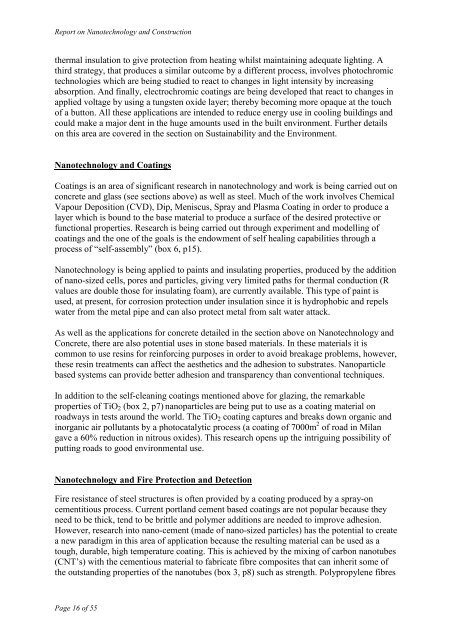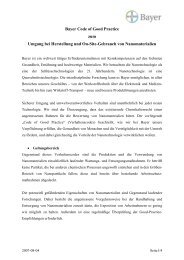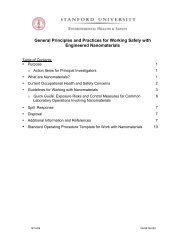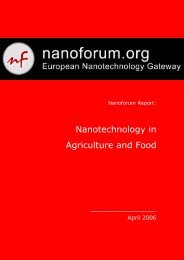Nanotechnology and Construction
Nanotechnology and Construction
Nanotechnology and Construction
Create successful ePaper yourself
Turn your PDF publications into a flip-book with our unique Google optimized e-Paper software.
Report on <strong>Nanotechnology</strong> <strong>and</strong> <strong>Construction</strong><br />
thermal insulation to give protection from heating whilst maintaining adequate lighting. A<br />
third strategy, that produces a similar outcome by a different process, involves photochromic<br />
technologies which are being studied to react to changes in light intensity by increasing<br />
absorption. And finally, electrochromic coatings are being developed that react to changes in<br />
applied voltage by using a tungsten oxide layer; thereby becoming more opaque at the touch<br />
of a button. All these applications are intended to reduce energy use in cooling buildings <strong>and</strong><br />
could make a major dent in the huge amounts used in the built environment. Further details<br />
on this area are covered in the section on Sustainability <strong>and</strong> the Environment.<br />
<strong>Nanotechnology</strong> <strong>and</strong> Coatings<br />
Coatings is an area of significant research in nanotechnology <strong>and</strong> work is being carried out on<br />
concrete <strong>and</strong> glass (see sections above) as well as steel. Much of the work involves Chemical<br />
Vapour Deposition (CVD), Dip, Meniscus, Spray <strong>and</strong> Plasma Coating in order to produce a<br />
layer which is bound to the base material to produce a surface of the desired protective or<br />
functional properties. Research is being carried out through experiment <strong>and</strong> modelling of<br />
coatings <strong>and</strong> the one of the goals is the endowment of self healing capabilities through a<br />
process of “self-assembly” (box 6, p15).<br />
<strong>Nanotechnology</strong> is being applied to paints <strong>and</strong> insulating properties, produced by the addition<br />
of nano-sized cells, pores <strong>and</strong> particles, giving very limited paths for thermal conduction (R<br />
values are double those for insulating foam), are currently available. This type of paint is<br />
used, at present, for corrosion protection under insulation since it is hydrophobic <strong>and</strong> repels<br />
water from the metal pipe <strong>and</strong> can also protect metal from salt water attack.<br />
As well as the applications for concrete detailed in the section above on <strong>Nanotechnology</strong> <strong>and</strong><br />
Concrete, there are also potential uses in stone based materials. In these materials it is<br />
common to use resins for reinforcing purposes in order to avoid breakage problems, however,<br />
these resin treatments can affect the aesthetics <strong>and</strong> the adhesion to substrates. Nanoparticle<br />
based systems can provide better adhesion <strong>and</strong> transparency than conventional techniques.<br />
In addition to the self-cleaning coatings mentioned above for glazing, the remarkable<br />
properties of TiO 2 (box 2, p7) nanoparticles are being put to use as a coating material on<br />
roadways in tests around the world. The TiO 2 coating captures <strong>and</strong> breaks down organic <strong>and</strong><br />
inorganic air pollutants by a photocatalytic process (a coating of 7000m 2 of road in Milan<br />
gave a 60% reduction in nitrous oxides). This research opens up the intriguing possibility of<br />
putting roads to good environmental use.<br />
<strong>Nanotechnology</strong> <strong>and</strong> Fire Protection <strong>and</strong> Detection<br />
Fire resistance of steel structures is often provided by a coating produced by a spray-on<br />
cementitious process. Current portl<strong>and</strong> cement based coatings are not popular because they<br />
need to be thick, tend to be brittle <strong>and</strong> polymer additions are needed to improve adhesion.<br />
However, research into nano-cement (made of nano-sized particles) has the potential to create<br />
a new paradigm in this area of application because the resulting material can be used as a<br />
tough, durable, high temperature coating. This is achieved by the mixing of carbon nanotubes<br />
(CNT’s) with the cementious material to fabricate fibre composites that can inherit some of<br />
the outst<strong>and</strong>ing properties of the nanotubes (box 3, p8) such as strength. Polypropylene fibres<br />
Page 16 of 55

















